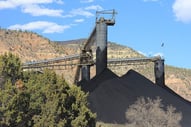 In March 2017, President Trump issued an executive order (EO) “Promoting Energy Independence and Economic Growth,” which packaged a set of repeals and re-directions to move US federal policies firmly away from climate change and toward domestic fossil fuels. (I wrote about it here). Among its many provisions, the EO directs federal agencies, including the Environmental Protection Agency (EPA), to “review all existing regulations, orders, guidance documents, policies, and any other similar agency actions (collectively, “agency actions”) that potentially burden the development or use of domestically produced energy resources…” The EO also orders EPA to review several specific rules.
In March 2017, President Trump issued an executive order (EO) “Promoting Energy Independence and Economic Growth,” which packaged a set of repeals and re-directions to move US federal policies firmly away from climate change and toward domestic fossil fuels. (I wrote about it here). Among its many provisions, the EO directs federal agencies, including the Environmental Protection Agency (EPA), to “review all existing regulations, orders, guidance documents, policies, and any other similar agency actions (collectively, “agency actions”) that potentially burden the development or use of domestically produced energy resources…” The EO also orders EPA to review several specific rules.
On October 25, EPA published a final report completing this set of tasks. In developing the report, EPA solicited public comments, and also coordinated with other internal reviews underway at the agency. Consistent with the general approach taken by the Trump administration and EPA Administrator Scott Pruitt, the report takes a literal approach to reducing “burdens” by easing regulatory standards and expediting (critics tend to say short-cutting) procedures.
Reforming Clean Air Act “New Source Review”
As part of its broader approach to reducing emissions from stationary sources (such as power plants), the Clean Air Act (CAA) requires pre-construction “New Source Review” of major source projects – including significant modification to existing sources as well as purely new sources -- in several general situations.
There are three types of NSR permits:
-
Prevention of Significant Deterioration (PSD) permits for new major sources or a major source making a major modification in an area that is in attainment with national ambient air quality standards (NAAQSs) (to keep clean air from getting dirty).
-
Nonattainment NSR permits for new major sources or major sources making a major modification in a nonattainment area (to keep dirty air from getting dirtier).
-
Minor source permits, when a state regulator determines these are necessary.
NSR permit reviews tend to be complex and detailed, as regulators and source personnel investigate ways to design an emitting facility to meet CAA goals. Agencies have developed numerous New Source Performance Standards, each of which offers generalized requirements for the types of equipment and sources it covers – so some new source reviews consist of straightforward selection of “off the shelf” standards. Others can be source-specific, and therefore time-consuming and complicated. EPA’s final report emphasizes the second type:
“Commenters noted that the NSR permitting process is unduly lengthy and complex. Commenters further stated that the NSR application and construction costs are exceedingly high, to the point of discouraging industry from modernizing facilities for fear of triggering NSR obligations.
Several commenters suggested that EPA should defer to state decisions on the applicability of NSR requirements and other source-specific permitting decisions. Commenters also raised concerns about the availability and cost of emissions offsets in nonattainment areas, and about whether costs will increase as various NAAQS are revised.
Commenters recommended reforms to allow the purchase of offsets from outside a nonattainment area, and inter-pollutant trading. Commenters also urged EPA to better promote and facilitate use of Plant-wide Applicability Limitations, which generally can allow domestic energy production facilities to modify equipment and operations without concerns of triggering NSR requirements. Finally, recommendations included reviewing the debottlenecking rule and re-proposing it to address NSR requirements for modifying sources.”
With these approaches in mind, the Final Report states the agency’s intention to convene an NSR Reform Task Force, details of which are to be announced later.
Reforming National Ambient Air Quality Standards (NAAQSs) Review and Implementation
The Final Report also finds fault with the procedures by which EPA promulgates NAAQSs, reviews existing NAAQSs for possible revision, and oversees state efforts to attain and maintain NAAQSs within their boundaries. EPA sets NAAQS for six criteria pollutants: ozone, nitrogen dioxide (NO2), sulfur dioxide (SO2), particulate matter (PM10 and PM2.5), carbon monoxide (CO), and lead. EPA establishes primary standards to protect public health and secondary standards to protect public welfare. CAA requires EPA to review and, if appropriate, revise each NAAQS every five years (although EPA has not consistently met that schedule over time).
The Final Report notes that a new or revised NAAQS, and an updated EPA determination whether a particular area is in attainment, can have substantial effects on emission sources, including the energy industry sources addressed by the EO. The Final Report notes that commenters raised questions about:
-
The stringency of some NAAQS, as well as the short review time between revisions (which is set by statute, not EPA rule).
-
Lags and inconsistencies in EPA guidance policies and documents, which complicate planning and compliance efforts.
-
Lags between NAAQSs issuance, state responses in their CAA state implementation plans (SIPs), and EPA review and approval or disapproval of SIP provisions, which also complicate planning and compliance efforts.
-
Narrowness of “exceptional event” exceptions to emission requirements, which might be eased to increase flexibility.
The Final Report notes that “EPA plans to work to streamline SIP approvals through a nationally consistent process that includes setting performance targets, and better monitoring progress on SIP reviews. EPA further plans to work to eliminate the SIP backlog.” EPA has already formed the Ozone Cooperative Compliance Task Force to address implementation of the 2015 revisions to the ozone NAAQS. Task Force priorities include review of administrative options to “enable states to enter into cooperative agreements with EPA to provide regulatory relief and meaningfully improve ozone air quality.” EPA has also deferred deadlines under the 2015 ozone standard by one year.
Expediting Review of the Economic Impacts of Regulation
The Final Report also includes, under an “Employment Evaluations” heading, a list of required analyses of the economic impact of regulations which are overdue. EPA commits to conducting these evaluations, to address effects on “business development and expansion, as well as capital investment and employment patterns.”
Launching the “Smart Sectors” Program
The Final Report also makes note of EPA’s recently-launched “Smart Sectors” program earlier in October. As summarized in materials for the new program, it focuses on:
-
Meaningful Collaboration with Regulated Sectors – EPA will partner with trade associations representing industry groups, assigning each a “program lead” at the agency to serve as an ombudsman and partner in “open dialogue.” Initial sectors consist of: Aerospace; Agriculture; Automotive; Cement; Concrete; Chemical Manufacturing; Construction; Electronics and Technology; Forestry, Paper and Wood Products; Iron and Steel; Mining; Oil and Gas; Ports and Marine; and Utilities and Power Generation.
-
Sensible Policies to Improve Environmental Outcomes – EPA will use this new partnership to “consider more forward-thinking ways to improve environmental outcomes”.
-
Better EPA Practices and Streamlined Operations - EPA will also use this new partnership to “facilitate better communication and streamline operations internally at EPA”.
Self-Assessment Checklist
Does the organization conduct activities involved in the development of domestic energy resources?
Does the organization conduct activities that are subject to CAA permit requirements?
-
Are any subject to requirements to reduce emissions of criteria pollutants subject to NAAQSs?
-
Are any subject to any of EPA’s new source review programs?
Does the organization conduct activities within any of the sectors designate for partnership by EPA’s Smart Sectors program?
Where Do I Go For More Information?
-
EPA’s Final Report
-
EPA Smart Sectors program page
-
Executive Order 13783 (Federal Register version)
Specialty Technical Publishers (STP) provides a variety of single-law and multi-law services, intended to facilitate clients’ understanding of and compliance with requirements. These include:
About the Author
 Jon Elliott is President of Touchstone Environmental and has been a major contributor to STP’s product range for over 25 years. He was involved in developing 13 existing products, including Environmental Compliance: A Simplified National Guide and The Complete Guide to Environmental Law.
Jon Elliott is President of Touchstone Environmental and has been a major contributor to STP’s product range for over 25 years. He was involved in developing 13 existing products, including Environmental Compliance: A Simplified National Guide and The Complete Guide to Environmental Law.
Mr. Elliott has a diverse educational background. In addition to his Juris Doctor (University of California, Boalt Hall School of Law, 1981), he holds a Master of Public Policy (Goldman School of Public Policy [GSPP], UC Berkeley, 1980), and a Bachelor of Science in Mechanical Engineering (Princeton University, 1977).
Mr. Elliott is active in professional and community organizations. In addition, he is a past chairman of the Board of Directors of the GSPP Alumni Association, and past member of the Executive Committee of the State Bar of California's Environmental Law Section (including past chair of its Legislative Committee).
You may contact Mr. Elliott directly at: tei@ix.netcom.com

